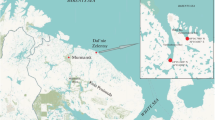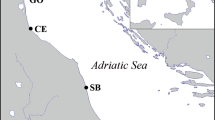Abstract
Seasonality in spicule production of the demosponge Halichondria panicea (Pallas, 1766) was studied in the Western Baltic from July 1992 to July 1993. Spicule production increased in parallel with increasing temperatures in spring, being most pronounced during summer after release of larvae. Large proportions of up to 30% immature spicules occurred in the population during skeleton production peaks, and this resulted in reduction of mean spicule dimensions by ≃20%. Effects on spicule width were more obvious than on spicule length. In winter, when wave forces were largest, higher percentages of mineral skeleton were observed: 50% of dry weight compared to 40% in summer. Enhanced spicule densities in the tissues were not attained by marked spicule production but through a reduction in organic content by shrinking. In spring, growth of body tissue was faster than the build-up of skeleton, so that the relative amount of the latter was reduced. The indirect, growth-related developments of the skeleton were inversely proportional to temperature and directly to salinity, silicate concentrations and wave energy. Spicule size and the number of immature spicules were correlated with temperature and only slightly with salinity. No correlation with oxygen concentration or pH could be detected.
Similar content being viewed by others
Author information
Authors and Affiliations
Additional information
Received: 3 April 1997 / Accepted: 8 August 1997
Rights and permissions
About this article
Cite this article
Schönberg, C., Barthel, D. Inorganic skeleton of the demosponge Halichondria panicea. Seasonality in spicule production in the Baltic Sea. Marine Biology 130, 133–140 (1997). https://doi.org/10.1007/s002270050232
Issue Date:
DOI: https://doi.org/10.1007/s002270050232




